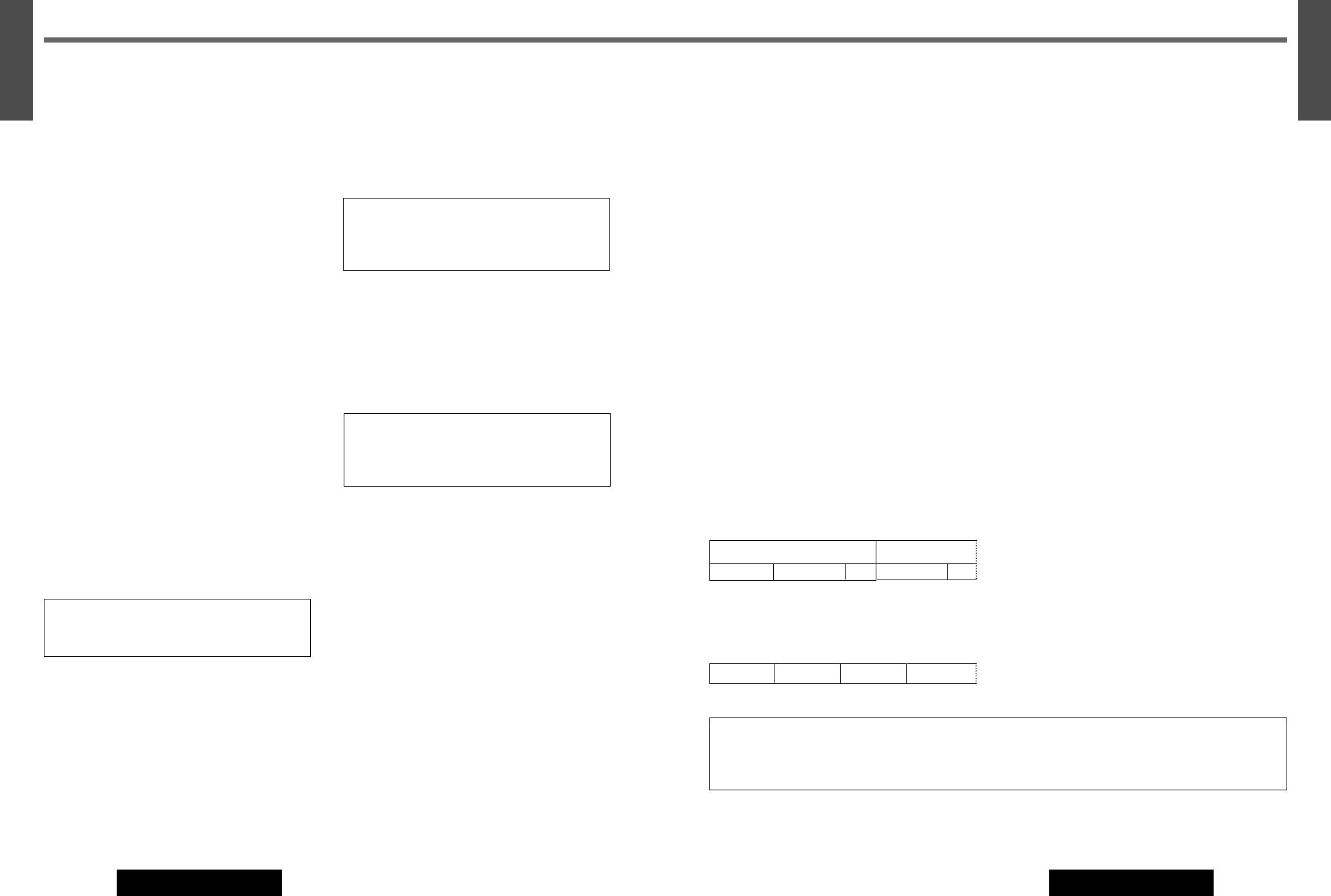
89
73
E
N
G
L
I
S
H
CQ-VD7700U/VD7500U
88
72
E
N
G
L
I
S
H
CQ-VD7700U/VD7500U
Definition of Terms
Digital audio output connector (Optical)
The digital audio output connector (optical) converts
electrical signals into optical signals and transfers
them to the amplifier. Consequently, it has a number
of features including its immunity from electrical inter-
ference from external sources and its ability to prevent
the generation of noise and its minimal effect on the
external environment. This function is provided only
with CQ-VD7500U
Dolby Digital
This fully discrete format divides the music signals
into 5.1 channels: Front Left (L), Front Right (R),
Center (C), Left Surround (LS), Right Surround (RS)
and Subwoofer (SW: 0.1 channel) for recording and
playback. The number of channels that are recorded
depends on the software (1 to 5.1 channels).
Dolby Digital 5.1
Dolby Digital 5.1 is a method of transmitting and stor-
ing 5.1-channel soundtracks via newer digital media
such as DVD, digital cable, digital broadcast TV (DTV),
and satellite transmissions. Unlike the Dolby Surround
encode/Pro Logic decode process, which sacrifices
channel separation to get surround onto any stereo
soundtrack, Dolby Digital 5.1 is a discrete system that
keeps the multiple channels fully separated through-
out the encoding and decoding processes. In addition
to having full-range Left (L), Center (C), Right (R), Left
Surround (LR), and Right Surround (RS) channels,
Dolby Digital 5.1 soundtracks carry a sixth (“.1”)
channel (Subwoofer) recorded with low-frequency
effects (those bass rumbles and booms you feel as
well as hear in a well-equipped cinema).
Dolby Pro Logic
This format records signals from four channels [Front
Left (L), Front Right (R), Center (C), and Monaural
Surround (S)] in two channels, decodes those chan-
nels through a Dolby Pro Logic decoder, and then out-
puts the resulting signals in four channels.
Dolby Pro Logic II
Dolby Pro Logic II is an advanced matrix decoder that
derives five-channel surround (Left, Center, Right, Left
Surround, and Right Surround) from any stereo pro-
gram material, whether or not it has been specifically
Dolby Surround encoded. On encoded material such
as movie soundtracks, the sound is more like Dolby
Digital 5.1 (see above), while on unencoded stereo
material such as music CDs the effect is a wider, more
involving soundfield. Among other improvements over
Pro Logic, Pro Logic II provides two full-range sur-
round channels, as opposed to Pro Logic’s single, lim-
ited-bandwidth surround channel.
dts
This format requires more data than Dolby Digital, and
provides higher quality surround playback.
Similar to Dolby Digital, this fully discrete format
divides the music signals into 5.1 channels: Front Left
(L), Front Right (R), Center (C), Left Surround (LS),
Right Surround (RS) and Subwoofer (SW: 0.1 chan-
nel) for recording and playback.
G.726
G.726 is a sound data standard of compression/expansion
recommended by CCITT (Consultative Committee for
International Telephony and Telegraphy). Applying this
standard, the PCM (Pulse Code Modulation) sound data
can be compressed or expanded effectively.
The applied software is mainly used for digital telephones,
digital voice recorders, digital camcorders and so on.
Interactive DVD
An interactive DVD is DVD software which includes
multiple angles, multiple plot endings, etc.
Letterbox screen
This refers to a screen on which the playback picture
of wide-screen DVDs or Video CDs appears with black
bands running along the top and bottom.
Pan & Scan screen
This refers to a screen on which the playback picture
of wide-screen DVDs or Video CDs is cut off at the left
and right sides.
Manufactured under license from Dolby
Laboratories. “Dolby” and the double-D symbol
are trademarks of Dolby Laboratories.
Manufactured under license from Dolby
Laboratories. “Dolby”, “Pro Logic”, and the
double-D symbol are trademarks of Dolby
Laboratories.
LPCM (Linear PCM audio)
In this format, the audio signal is converted to digital
data and recorded in two channels without compres-
sion. Because the capacity of a DVD video disc is
large, it can store more data with better accuracy than
a CD.
MPEG4
MPEG4 (ASF) is an audio/video format for the online
streaming proposed by Microsoft Corporation. This format
allows you to treat audio/video data easily on your personal
computer.
Generally, ASF files are so light that they can be stored on
comparatively small-capacity media such as SD memory
card because they are made for online streaming.
Playback control (Video CD)
If the Video CD has “With Playback Control” or some-
thing similar written on the disc surface or on the
jacket, the scenes or information to be viewed (or lis-
tened to) can be selected interactively by using the
menu shown on the screen.
In these instructions, playback using the menu screen
is referred to as “menu play” for video CDs. This play-
er supports Video CDs with playback control.
Title, Chapter (DVD)
DVDs are divided into large sections (titles) and/or
small sections (chapters). Each section is numbered;
these numbers are called “Title number” or “Chapter
number”.
Track (Video CD/CD)
Video CDs or CDs are divided into some sections
(tracks). Each section is numbered; these numbers are
called “Track number”.
Chapter 1
Chapter 2
……
Chapter 1
……
Title 1 Title 2
“DTS” and “DTS Digital Surround” are registered
trademarks of Digital Theater Systems, Inc.
“DTS” and “DTS 2.0” are trademarks of Digital
Theater Systems, Inc.
Track 1 Track 3Track 2
……
Track
This product incorporates copyright protection technology that is protected by U.S. patents and other intellectual
property rights. Use of this copyright protection technology must be authorized by Macrovision, and is intended for
home and other limited viewing uses only unless otherwise authorized by Macrovision. Reverse engineering or
disassembly is prohibited.


















